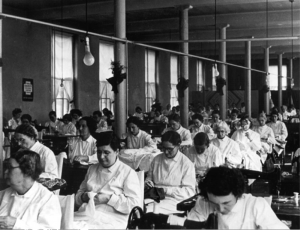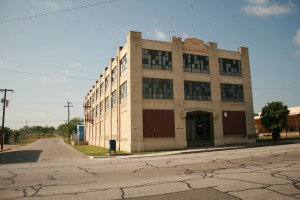For most people, the name WPA brings to mind images of men laboring on highway projects and building parks and schools, but during the Depression, women, too, were heads of households and in need of employment. Work programs for women were first established in 1933 through the Women’s Division of the Federal Emergency Relief Administration (FERA), and later came under the Works Progress Administration (WPA). Some women were placed in clerical jobs or worked as librarians, others went to work canning, gardening, and sewing. Nationally, some 7 percent of WPA workers were women engaged in sewing projects. Sewing rooms could be found in rural areas and large cities alike.
In Fort Worth, Texas, for example, the first sewing room opened in 1935. Later, separate sewing rooms were created for white and African American women. Job training was provided. Illiterate women received basic educational instruction. Starting pay was $35 a month for 140 hours work. The federal government paid for salaries, with the city and county paying a percentage of expenses. All the items produced stayed in Tarrant County.
The Fort Worth seamstresses took great pride in their work, proclaiming that the initials “WPA” stood for “We Patch Anything.” They repaired used clothing and created new garments, for which each woman was responsible from beginning to end. Each item included a WPA label with the inscription “Not to be sold.” The finished items were sent to the surplus commodities depot to be distributed to needy individuals—sometimes the women themselves—on the order of city and county welfare workers.
The worker’s average output was two and a half garments a day (not including trim), and included men’s trousers, boys’ coveralls, baby clothes, and diapers. So as not to stigmatize those who were issued WPA clothing, great care was taken to create unique designs. A special department altered stock patterns. The local newspaper noted that one pattern could be used for fifty dresses, yet no two would look alike.
By 1940, Fort Worth’s sewing rooms employed 650 women ranging in age from 35 to 64. The work month had been shortened to 130 hours but pay had increased to $46.80. The sewing rooms in Fort Worth reportedly produced 2,341,369 garments and 130,408 household articles.
As the United States geared up for World War II, many women found better paying jobs in the defense industries. The WPA sewing rooms were disbanded in 1941, ending a successful and popular program that gave women not only the means to provide for themselves and their families, but also skills, camaraderie, and a sense of self worth.


Do you know how sewing machines were dispersed of, once the sewing rooms were closed? I believe I have a machine and I am trying to see if there is away to track where it was from. Thank you.
Please contact [email protected]— hopefully we can figure out a way to track your machine.
This is very interesting. I had never heard of W.P.A. before finding a 1940 census in unincorporated Midway, Texas area in Madison County, Texas where one of my BROWN family members lived. It shows living on Midway-Huntsville Rd. I found the he worked for Murry Farm as a ‘timekeeper’ and she worked for W.P.A. as a seamstress. I neighbor lady Mrs Myrtle Pearson is also show as being a WPA seamstress too. I have not yet figured out where “Murry Farm” is but I would guess it could possibly be where the WPA is located where these two ladies worked too.
Mrs Pearson’s husband just said ‘farmer’ but Johnie Brown said works at Murry Farm as a timekeeper while his wife Lila is a WPA timekeeper. Johnie j Brown and wife Lila are my relations. I am not related to the Pearson neighbor to my knowledge.
So I searched for what WPA meant and found this webpage on “We Patch Anything” in Ft Worth, Texas are and find this very interesting. 1940 Census: Does anyone know anything about a WPA on a Murry Farm in Madison County Texas near the end of unincorporated Midway and residences on the entire page are listed as “Midway – Huntsville Rd” (Madison county, Texas)? Perhaps Lila’s husband was some type of timekeeper for workers of WPA??
After reading this WPA Ft Worth TX area webpage, I guess 1941 the Madison County, Texas area WPA’s must have closed too. Feel free to email me if anyone has information above WPA history in Madison County, Texas in unincorporated Midway area. [email protected]
My great great grandma work here in 1939. To support her 3 kids she was raising at home. How neat this place I can look at this place and say wow my great great grandma work there